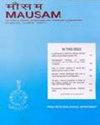Impact outlook of Asian Monsoon for Disaster Resilience
IF 0.7
4区 地球科学
Q4 METEOROLOGY & ATMOSPHERIC SCIENCES
引用次数: 0
Abstract
The Asian summer monsoon impacts the human lives and agrarian economies throughout Asia. These impacts are driven by monsoon anomalies which are manifested interms of the seasonal precipitation, surface temperatures, and the occurrences of floods,droughts, and tropical cyclones. A strong monsoon results in various positive outcomes like increased agricultural produce, economic growth,reduced commodityprices and national inflationary levels as well as increased ground water and restored reservoirs.While predicting the Asian summer monsoon has been prioritized by decision-makers across sectors in Asia, impact forecasting must gain greater significance as itis particularly important to tackle disaster risks. The paradigm shifts from ‘what monsoon will be to what monsoon will do’provides valuable insightsto better prepare Asian countries for managingimpending extreme events. The paper brings out how impact outlook for Asian monsoon can be effectively utilized.It shows howseasonal forecasts overlaid with risk and hazards maps andindicators on exposure and vulnerability can enhance understanding ofpotential risk scenariosfor various sectors, including agriculture, energy, health, water, and disaster management. Noting the limitations of accuracy and information available from seasonal forecasts, the information provided from impact outlook should be understood as preliminary assessments. The paper makes a case for seamless integration of seasonal, sub-seasonal, medium, and short terms forecasts withthe data on potential impact for close monitoring and taking targeted policy actions.亚洲季风对抗灾能力的影响展望
亚洲夏季风影响着整个亚洲的人类生活和农业经济。这些影响是由季风异常引起的,季风异常表现为季节性降水、地表温度以及洪水、干旱和热带气旋的发生。强劲的季风带来了各种积极的结果,如农产品增加、经济增长、商品价格下降和国家通货膨胀水平下降,以及地下水增加和水库恢复。虽然预测亚洲夏季风已成为亚洲各部门决策者的优先事项,但影响预测必须具有更大的意义,因为它对应对灾害风险尤为重要。从“什么是季风到什么是季风”的范式转变为亚洲国家更好地应对即将到来的极端事件提供了宝贵的见解。文章提出了如何有效利用亚洲季风的影响前景。它显示了覆盖风险和危害地图以及暴露和脆弱性指标的个人预测如何增强对农业、能源、卫生、水和灾害管理等各个部门潜在风险情景的理解。注意到季节性预测的准确性和可用信息的局限性,应将影响展望提供的信息理解为初步评估。本文提出了将季节性、次季节性、中期和短期预测与潜在影响数据无缝结合的理由,以便密切监测和采取有针对性的政策行动。
本文章由计算机程序翻译,如有差异,请以英文原文为准。
求助全文
约1分钟内获得全文
求助全文
来源期刊

MAUSAM
地学-气象与大气科学
CiteScore
1.20
自引率
0.00%
发文量
1298
审稿时长
6-12 weeks
期刊介绍:
MAUSAM (Formerly Indian Journal of Meteorology, Hydrology & Geophysics), established in January 1950, is the quarterly research
journal brought out by the India Meteorological Department (IMD). MAUSAM is a medium for publication of original scientific
research work. MAUSAM is a premier scientific research journal published in this part of the world in the fields of Meteorology,
Hydrology & Geophysics. The four issues appear in January, April, July & October.
 求助内容:
求助内容: 应助结果提醒方式:
应助结果提醒方式:


